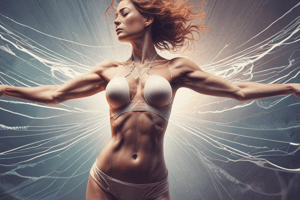Podcast
Questions and Answers
Which type of body movements involve the body traveling from one location to another point?
Which type of body movements involve the body traveling from one location to another point?
- Stationary movements
- Non-locomotor movements
- Locomotor movements (correct)
- Axial movements
Which of the following is NOT an example of even rhythmic locomotor movement?
Which of the following is NOT an example of even rhythmic locomotor movement?
- Running
- Jumping
- Leaping
- Skipping (correct)
What term is sometimes used to refer to non-locomotor movements?
What term is sometimes used to refer to non-locomotor movements?
- Dynamic movements
- Circular movements
- Travelling movements
- Axial movements (correct)
Which of the following is an example of a non-locomotor movement?
Which of the following is an example of a non-locomotor movement?
Which type of locomotor movement consists of unequal actions and sometimes alternating actions?
Which type of locomotor movement consists of unequal actions and sometimes alternating actions?
Which category of body movements involves combining both locomotor and non-locomotor actions?
Which category of body movements involves combining both locomotor and non-locomotor actions?
What is the definition of physical activity according to the World Health Organization (WHO)?
What is the definition of physical activity according to the World Health Organization (WHO)?
How is physical exercise different from physical activity?
How is physical exercise different from physical activity?
How are endurance, strength, balance, and flexibility classified in relation to physical exercise?
How are endurance, strength, balance, and flexibility classified in relation to physical exercise?
Which type of physical exercise helps enhance the ability to perform other types of exercises?
Which type of physical exercise helps enhance the ability to perform other types of exercises?
Why is variation important in physical exercises according to the text?
Why is variation important in physical exercises according to the text?
How do exercises that improve strength, flexibility, balance, and mobility contribute to an individual's well-being?
How do exercises that improve strength, flexibility, balance, and mobility contribute to an individual's well-being?
Why should regular exercise be a priority?
Why should regular exercise be a priority?
What type of physical activities are recommended for Filipino children aged 5-12 years?
What type of physical activities are recommended for Filipino children aged 5-12 years?
How long should adolescents and young adults engage in daily physical activity?
How long should adolescents and young adults engage in daily physical activity?
What type of physical activities are recommended for Filipino adolescents and young adults?
What type of physical activities are recommended for Filipino adolescents and young adults?
Which of the following is NOT a benefit of regular exercise mentioned in the text?
Which of the following is NOT a benefit of regular exercise mentioned in the text?
What should be included in programmed physical activities for adolescents and young adults according to the text?
What should be included in programmed physical activities for adolescents and young adults according to the text?
Study Notes
Types of Fundamental Body Movements
- Locomotor movements refer to the body's movements that travel from one location to another point.
- There are eight major locomotor movements, classified as either even movements or irregular movements.
- Even rhythmic movements include walking, running, hopping, leaping, and jumping.
- Uneven rhythm movements include skipping, galloping, and sliding.
Examples of Locomotor Movements
- Jumping
- Hopping
- Leaping
- Sliding
- Rolling
- Walking
- Jogging
- Running
Non-Locomotor Movements
- Non-locomotor movements, also called axial movements, refer to the body's movements without traveling.
- Examples include bending, shaking, stretching, swaying, swinging, turning, twisting, and wiggling.
Examples of Non-Locomotor Movements
- Stretching
- Bending
- Swinging
- Swaying
Defining Physical Activity
- Physical activity (PA) is defined as any bodily movement produced by skeletal muscles that involves energy expenditure.
- PA encompasses all bodily movements, whether for recreation, transportation, or as part of a person's choice or career.
Physical Activity and Physical Exercise
- Physical activity is any movement that requires energy from the muscles.
- Physical exercise is defined as movement that is planned, systematic, repetitive, and intentional.
- Physical exercise is classified into four types: endurance, strength, balance, and flexibility.
Benefits of Physical Exercise
- Improves memory and cognitive function
- Helps with weight loss
- Reduces blood pressure and improves cardiovascular health
- Improves sleep quality
- Reduces symptoms of depression and anxiety
- Combats weariness caused by cancer
- Reduces joint stiffness and pain
- Keeps muscle strength and balance
- Increases life expectancy
Physical Activity Prescription
- Children (5-12 years old): at least 60 minutes daily physical activities, including active daily tasks, exercise, dance, or sports, and high impact play.
- Adolescents to Young Adults (13-20 years old): at least 60 minutes of daily physical activity, including active daily tasks, exercise, dance, or sports, and high impact play.
Studying That Suits You
Use AI to generate personalized quizzes and flashcards to suit your learning preferences.
Description
Learn about the two types of basic body movements: locomotor movements and non-locomotor movements. Explore the eight major locomotor movements and understand the differences between even rhythmic movements and irregular movements.




